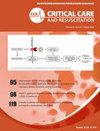基于基因表达的氢化可的松在感染性休克患者中的精准应用肾上腺试验的二次分析
IF 1.7
4区 医学
Q3 CRITICAL CARE MEDICINE
引用次数: 0
摘要
背景:小型观察性研究表明,皮质类固醇对血管扩张性休克患者的影响取决于基因表达决定的内源性类型。我们试图在一个更大的随机临床试验队列中重复这些发现。方法在一项脓毒性休克辅助糖皮质激素治疗(ADRENAL)试验的横断面亚研究中,使用预先定义的基因表达特征将患者分为两种免疫内型:免疫适应性流行型(IA-P)或免疫先天流行型(In -p)。我们使用贝叶斯分析比较了两种内型的结果。主要终点为第28天死亡率。540例患者中,267例(49.4%)为IA-P, 273例(50.6%)为IN-P。在使用非信息先验的贝叶斯分析中,氢化可的松对28天死亡率的影响在IA-P组和In - p组之间分别没有差异(比值比[OR] 1.43, 95%可信区间[CrI] 0.72-2.87)和OR 1.39, 95%可信区间[CrI] 0.74-2.61)。在较重度休克患者亚组(n = 215/540, 40%), IA-P和In - p对应的数值分别为1.21、95% CrI(0.31-4.74)和OR 0.72 (95% CrI 0.30-1.67)。在肺脓毒症患者亚组中(232/540,43%),接受氢化可的松治疗的IA-P患者死亡率增加(OR 5.55, 95% CrI 1.81-21.2)。感染性休克患者的基因表达数据显示不同的免疫内型。没有证据表明氢化可的松对两种内源性或严重休克亚组死亡率的治疗效果存在异质性。IA-P内型和肺脓毒症患者似乎受到皮质类固醇的伤害。本文章由计算机程序翻译,如有差异,请以英文原文为准。
A gene expression-based approach for the precision use of hydrocortisone in septic shock patients; a secondary analysis of the ADRENAL trial
Background
Small observational studies suggest the effect of corticosteroids in patients with vasodilatory shock vary depending on endotypes determined by gene expression. We sought to replicate these findings in a larger cohort from a randomised clinical trial.
Methods
In a cross-sectional substudy of the Adjunctive Glucocorticoid Therapy In Septic Shock (ADRENAL) trial, patients were classified as one of two immune endotypes using predefined gene expression signatures: immune adaptive-prevalent (IA-P) or immune innate-prevalent (IN-P). We compared the outcomes of the two endotypes using a Bayesian analysis. The primary outcome was Day-28 mortality.
Findings
Of 540 patients, 267 (49.4%) were classified as IA-P and 273 (50.6%) as IN-P. In a Bayesian analysis using noninformative priors, there was no difference in the effect of hydrocortisone on 28-day mortality (odds ratio [OR] 1.43, 95% credible intervals [CrI] 0.72–2.87) and OR 1.39, 95% CrI 0.74–2.61, between the IA-P and IN-P groups, respectively. In the subgroup of patients with more severe shock (n = 215/540, 40%), the corresponding figures for IA-P and IN-P were 1.21, 95% CrI (0.31–4.74) and OR 0.72 (95% CrI 0.30–1.67), respectively. In the subgroup of patients with pulmonary sepsis (232/540, 43%), IA-P patients treated with hydrocortisone had increased mortality (OR 5.55, 95% CrI 1.81–21.2).
Interpretation
Gene expression data from patients with septic shock reveal distinct immune endotypes. There was no evidence of a heterogeneity of treatment effect of hydrocortisone on mortality in the 2 endotypes or in the subgroup with severe shock. Patients with the IA-P endotype and pulmonary sepsis appear to be harmed by corticosteroids.
求助全文
通过发布文献求助,成功后即可免费获取论文全文。
去求助
来源期刊

Critical Care and Resuscitation
CRITICAL CARE MEDICINE-
CiteScore
7.70
自引率
3.40%
发文量
44
审稿时长
>12 weeks
期刊介绍:
ritical Care and Resuscitation (CC&R) is the official scientific journal of the College of Intensive Care Medicine (CICM). The Journal is a quarterly publication (ISSN 1441-2772) with original articles of scientific and clinical interest in the specialities of Critical Care, Intensive Care, Anaesthesia, Emergency Medicine and related disciplines.
The Journal is received by all Fellows and trainees, along with an increasing number of subscribers from around the world.
The CC&R Journal currently has an impact factor of 3.3, placing it in 8th position in world critical care journals and in first position in the world outside the USA and Europe.
 求助内容:
求助内容: 应助结果提醒方式:
应助结果提醒方式:


